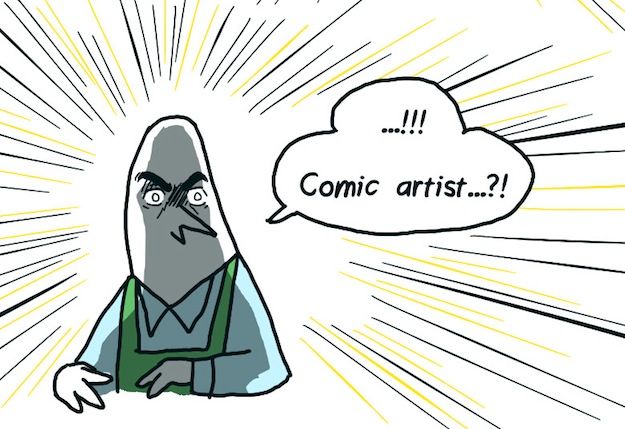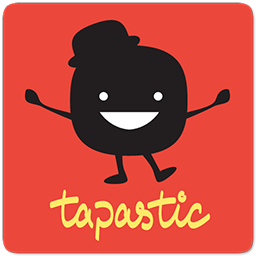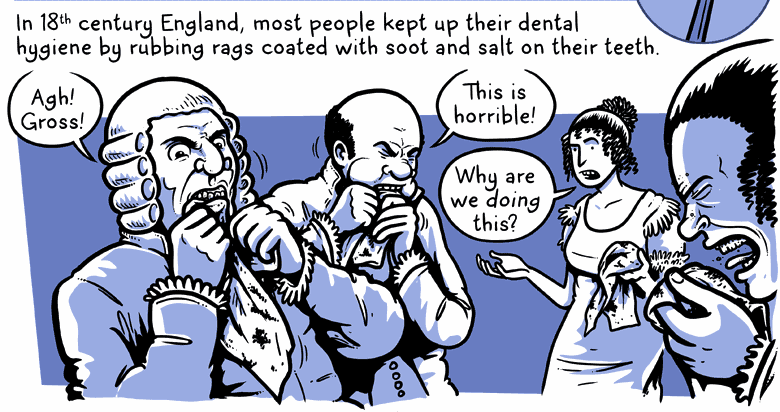Tapastic is a new digital-comics platform that allows users to upload their comics to the Internet. That isn't a new idea, and when Nina Kester, whom I first met when she was working with Archie, contacted me about it, my first question (asked and answered below) was "How is this different from SmackJeeves or Drunk Duck?" Well, I was a bit more polite than that.
One way to look at it is that Tapastic is webcomics sites 2.0. It's sleeker, more polished, and it has venture capital funding, so someone is planning to make money from it. I asked Nina to explain what Tapastic is up to, talk about the plans for WonderCon, and recommend a couple of her favorite comics from the site.
ROBOT 6: What sets Tapastic apart from other webcomics sites?
Nina Kester: The first thing everyone notices about Tapastic in contrast with other comic websites is our design. Our CPO Daron Akira Hall's minimalistic aesthetic for the site and Tapastic's apps and his design of the user experience always tend to be the first "wow" because it makes the content look so attractive. In his own words, "the main focus for the overall design UI from my perspective has been to keep it simple and flat, not too colorful … in order to let the content shine through, keeping the focus on the art, etc."
Tapastic also uses an "endless canvas" format that works well for cartoonists from other mediums (newspaper, monthly issues, webcomics, what have you) and opens up a new medium for digital comics to thrive and experiment in with animation and eventually other possibilities, like sound.
Tapastic's platform looks and reads nothing like the other webcomic or digital comic sites or reader apps, to me it's refreshingly bright and playful.
We also aim towards a different target demographic. Tapastic comics are for everyone from college students to executives or stay-at-home parents with all sorts of interests, not just comic geeks. Although we love it, too. The comics are serialized, bite-sized (hence Tapas-tic) and growingly diverse.
I also think that we have a more well-rounded team behind the platform. We have co-founders with experience at Google and multiple Silicon Valley start-ups that keep us limber and at the forefront of the tech sphere and designers and artists that breathe, eat and dream visual stories. I've personally been involved in the comics industry for over six years gaining experience from my time at Scholastic: Graphix, Archie Comics and Peanuts.
We're also not casual in our ambitions for the platform. We're on a path to become a place where everyone can read comics again as a nation, like so many of us did with the prevalence the Sunday funnies used to have, and as a global community. Part Facebook, part YouTube, part Tumblr and hopefully some day part of just about everyone's daily routine.
What value does a site like Tapastic add for creators? How is it better than just posting your own work on Tumblr?
I've tried reading comics on Tumblr, but it never felt organic. Tapastic is designed around the medium it specializes in, rather than the one size fits all platform. Tumblr fits better with non-linear themed content. Most Tumblr comics would work well on Tapastic, but many Tapastic comics that are linear on-going story lines would be difficult to read on Tumblr.
We break down creator benefits into three categories: exposure, community and monetization.
While doing our own publicity for the platform we promote our publishers whenever an appropriate opportunity arises. One of our publishers, Jewel Kats, has been extremely aggressive and successful in pursuing her own publicity for her series, "DitzAbled Princess," about a disabled diva, illustrated by Katarina Andriopoulos, among disabled or differently abled spheres. We're in talks to coordinate a campaign with her in October for National Disabilities Awareness Month.
We also provided white papers and guidance in blog posts and discussions in our forum. Tapastic's commitment to promoting our publishers and helping them learn how to and actually better promote themselves is critical. Our publisher community is also very eager to help one another. There's an overwhelming feeling that everyone is in it together and that everyone wants to see everyone succeed and be a part of that success.
As you can see, exposure is part of the benefit of our strong Tapastic community. Our publishers are active, so active that all of our staff has to pitch in to keep up with our private Publisher Group on Facebook. We just launched our forum and are already starting to see that activity spill over and grow at forums.tapastic.com.
We also make a commitment to give our publisher community face time and have held our first public Google Hangout with our entire office earlier this month. We would love to make it a regular thing. We also hold monthly meetup events in the Bay Area. This past weekend we had over 30 creators show up to our Mini-Comic Day Celebration Drink and Draw.
At WonderCon this weekend we will be launching our "Your Story Belongs on Tapastic!" postcard campaign to bring a personal community touch as convention goers invite their friends and favorite creators to join Tapastic. Attendees can find us at booth SP-78 to personalize their own for us to deliver.
Our last piece of the puzzle is monetization for our publishers. Visual storytellers put a lot of work and time into their series and we think they're worth their weight. We test different revenue sharing and monetization models for publishers through our Primetime Publisher Program. The current monetization for our publishers is a performance based compensation plan that rewards those who take initiative in pursuing and perfecting their own publicity to obtain series page views on Tapastic.
How is Tapastic monetized? Do you charge creators? Sell ads?
We do not charge creators, or as we call them, publishers. I was surprised to realize that companies do (with the exception of hosting your own site). As a larger culture we don't think that way anymore. Thanks to services like YouTube we think of places where everyone has an opportunity to be creative and tell their visual story and those who refine their skills and find a strong response to their work also have an opportunity to profit from partnering with us and sharing their content through our service.
Right now we're using our initial funding to monetize since we just launched in October of last year. We also just started serving limited ads, being sure that they don't interrupt the reading experience, which is far more important to us. We will continue to pull in funding as we explore and discover the monetization model that best works for Tapastic, our publishers and our readers.
How did it get started?
Tapastic was started when our co-founders Chang Kim and YJ Jang saw an opportunity to meet a desire. They know webtoons, Korean webcomics, have achieved a huge popularity in their own country, and with them, when pulled into a singular platform and wanted to bring that opportunity to US creators and fill that desire for US readers that were not being served well by other webcomic and illustrated visual story sources.
Now, after less than half a year, Tapastic is a platform that attracts millions of views each month on its website and through Tapastic apps for Android and iOS.
What’s your favorite comic on the site?
My first favorite and still favorite is One more J by Tato, who I was reading before I joined the Tapastic team. Anyone who has ever had artistic aspirations would enjoy it. The amount of laughter you experience might just be dangerous.
Another favorite is Brief Histories of Everyday Objects by Andy Warner, who I meet last year at the gallery Studio for Lark Pien's show. I'll be joining Andy and some other Bay Area cartoonists at Stumptown next month looking for more creators to invite to our publisher community.
Since our publisher community grows every day I'm thankful we have a subscription option so I can keep track of all the series I like and where I am in each of them instead of having to keep track of each individual website. Life is so much easier when your favorite bite-sized visual stories all hang out together. You might even say it makes life Tapastic!



